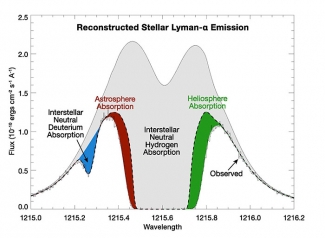Unlocking of the secrets of stellar winds, young stars, and exoplanet atmospheres has been quite challenging. First, the atmospheres of young stars and the dusty environments around them simply aren’t very transparent to Lyman-α radiation. Second, there’s hydrogen in a star, and there’s hydrogen around the star, and the Universe is filled with massive clouds of hydrogen atoms and molecules that absorb most of the Lyman-α radiation passing through them. Finally, we observe the Universe because the Hubble telescope uses the Lyman-α line of hydrogen as a probe of what it sees. Observers see all these things at the same time superimposed.
The ability to unravel this complicated picture improved dramatically in 2006 when Linsky and his colleagues figured out the reason for variations in the interstellar concentration of deuterium, an isotope of hydrogen with similar behavior and a spectral line located close to the Lyman-α line. Deuterium binds to dust grains in quiet regions of the interstellar medium and is released from the dust grains by shock waves produced by supernova explosions. The ability to determine consistent D/H ratios has opened the door to important discoveries that rely upon using the Lyman-α line.
First, it’s now possible to measure the rates at which dwarf stars like the Sun lose mass, which is important for understanding stellar evolution. For instance, astrophysicists have discovered that charge-exchanges occur between protons in stellar winds and hydrogen atoms flowing toward the star from the interstellar medium. This charge exchange causes heated and slowed H atoms to form a “hydrogen wall” inside stellar astrospheres (“bubbles” formed by stellar winds relatively far away from the host star). The astrosphere of our Sun (a.k.a. the heliosphere) extends beyond all eight major planets.
Second, stellar Lyman-α emission lines play a role in the study of planet formation in circumstellar disks around very young stars. In circumstellar disks, the Lyman-α line can probe trace amounts of hydrogen molecules and carbon monoxide gas left over near the end of the planet-forming process.
Finally, Lyman-α emission-line studies have increased our understanding of exoplanets. They have been used to show that gas giant exoplanets lose hydrogen and other elements though various types of outflows, including mass loss in comet-like tails. Lyman-α emission-lines also directly control the photochemistry of water, carbon dioxide, and methane in exoplanet atmospheres. Simulations of this process have shown that oxygen atoms and molecules as well as ozone (O3) can all be produced without requiring the presence of living organisms.
Linsky’s colleagues will have to identify a signal other than just the presence of oxygen for detecting life on exoplanets. But regardless of what happens in the search for alien life, the amazing Lyman-α line will continue to play an important role in increasing our understanding of the Universe.





